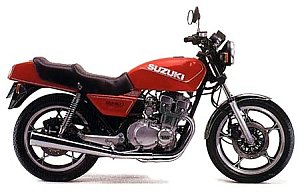 Ken wrote in response to the web-site generally, but in particular to the article “Oldies Can Be Goldies”. This article praised the practicalities of some older bikes; in some cases particularly, it showed that some “golden oldies” were more practical than today’s crop of bikes, which tend to be more focused on one riding task, and less on all-round enjoyment and practicality. And to illustrate, he told the story of bikes he has owned.
Ken wrote in response to the web-site generally, but in particular to the article “Oldies Can Be Goldies”. This article praised the practicalities of some older bikes; in some cases particularly, it showed that some “golden oldies” were more practical than today’s crop of bikes, which tend to be more focused on one riding task, and less on all-round enjoyment and practicality. And to illustrate, he told the story of bikes he has owned.
 The story of his bikes is fascinating. The market has been pursuaded (mislead?) into thinking that everyone should be riding a cruiser or a sports-bike that does good track times. It was fascinating to read about Ken’s experiences with his bikes.
The story of his bikes is fascinating. The market has been pursuaded (mislead?) into thinking that everyone should be riding a cruiser or a sports-bike that does good track times. It was fascinating to read about Ken’s experiences with his bikes.
KEN’S STORY
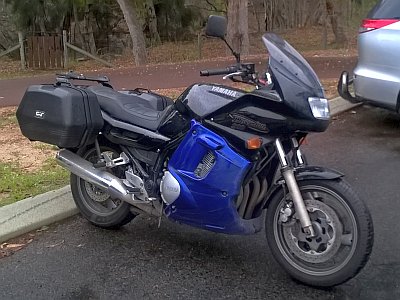
 At just shy of 60 years old, I suspect I may be smack in the middle of your target audience demographic. I stumbled onto your site while surfing the web for information on the Yamaha XJ900S Diversion, and found myself at your Oldies Can Be Goldies article.
At just shy of 60 years old, I suspect I may be smack in the middle of your target audience demographic. I stumbled onto your site while surfing the web for information on the Yamaha XJ900S Diversion, and found myself at your Oldies Can Be Goldies article.
 As the owner of a 2001 XJ900S I agree completely with your assessment of the bike.
As the owner of a 2001 XJ900S I agree completely with your assessment of the bike.
 I note also your very positive comments about Triumph bikes. My previous ride was a 2003 Tiger 955i, and for my purposes I rate the old Yamaha a superior machine. Doesn’t sound right does it, but there’s a bit of a story to it.
I note also your very positive comments about Triumph bikes. My previous ride was a 2003 Tiger 955i, and for my purposes I rate the old Yamaha a superior machine. Doesn’t sound right does it, but there’s a bit of a story to it.
 My motorcycle beginnings were on Japanese trail bikes during the early ‘70s, although by the late 70’s I was on Japanese road bikes. These included the delightful Honda CB400F and Yamaha’s trouble-plagued TX750: opposite ends of the spectrum in the riding and ownership experience.
My motorcycle beginnings were on Japanese trail bikes during the early ‘70s, although by the late 70’s I was on Japanese road bikes. These included the delightful Honda CB400F and Yamaha’s trouble-plagued TX750: opposite ends of the spectrum in the riding and ownership experience.
 By the early 80s, the wife, mortgage and children arrived and a reliable motorcycle was still the most cost effective transport option for me. A Suzuki GSX400F satisfied that requirement for eleven years and over 150,000 kilometres.
By the early 80s, the wife, mortgage and children arrived and a reliable motorcycle was still the most cost effective transport option for me. A Suzuki GSX400F satisfied that requirement for eleven years and over 150,000 kilometres.
 I purchased the Suzuki thinking it would be a “modern” Honda CB400F, but it was a vastly different ride; the only common elements being the capacity and four cylinders. The little GSX was designed to be competition for the Yamaha two-stroke RD400 and LC350 line, and as a consequence was something of a pocket rocket. In the finest Universal Japanese Motorcycle traditions, it was very capable over a variety of applications and great fun to ride. Despite having a voracious appetite for stators (a common issue with small capacity Suzuki four stroke road bikes in the early years), the GSX400F gave me quite an appreciation for Suzuki products, and when a second hand Suzuki VX800 turned up at the right price, the changeover was a painless decision.
I purchased the Suzuki thinking it would be a “modern” Honda CB400F, but it was a vastly different ride; the only common elements being the capacity and four cylinders. The little GSX was designed to be competition for the Yamaha two-stroke RD400 and LC350 line, and as a consequence was something of a pocket rocket. In the finest Universal Japanese Motorcycle traditions, it was very capable over a variety of applications and great fun to ride. Despite having a voracious appetite for stators (a common issue with small capacity Suzuki four stroke road bikes in the early years), the GSX400F gave me quite an appreciation for Suzuki products, and when a second hand Suzuki VX800 turned up at the right price, the changeover was a painless decision.
 The Suzuki VX800 was only ever seen by me as an “interim” bike, as by this time, the mid 90s, my career was progressing nicely, and I had promised myself a new Triumph as a “reward” for a particular career milestone I had achieved. At the time, my family was located in Queensland, and work had me in Sydney, so the VX800 was tasked with belting up and down the New England Highway with some regularity over the next six months or so. It proved itself to be a fabulous tourer, even allowing for the cast iron seat. Thank heavens for sheep skins, I say.
The Suzuki VX800 was only ever seen by me as an “interim” bike, as by this time, the mid 90s, my career was progressing nicely, and I had promised myself a new Triumph as a “reward” for a particular career milestone I had achieved. At the time, my family was located in Queensland, and work had me in Sydney, so the VX800 was tasked with belting up and down the New England Highway with some regularity over the next six months or so. It proved itself to be a fabulous tourer, even allowing for the cast iron seat. Thank heavens for sheep skins, I say.
 Once I brought the family down to Sydney, I set about finding the Triumph of my dreams. The first one I rode was the Triumph Thunderbird, the 855cc version, and I was desperately underwhelmed with it. Gutless, softly sprung, and weakly braked. (I suspect the Thunderbird was targeted at people who wanted the Triumph image but didn’t like riding very much). The sales dude must have seen my face when we got back from the test ride and immediately thrust into my hand the keys to a Trident. Here was a bike which was much more to my liking and I thought it might just be the bike for me. Trouble was though, when I headed off for the ride home, I found the Trident was not $10,000 (the changeover figure at the time) better than the old VX800 I was riding. A very telling comparison.
Once I brought the family down to Sydney, I set about finding the Triumph of my dreams. The first one I rode was the Triumph Thunderbird, the 855cc version, and I was desperately underwhelmed with it. Gutless, softly sprung, and weakly braked. (I suspect the Thunderbird was targeted at people who wanted the Triumph image but didn’t like riding very much). The sales dude must have seen my face when we got back from the test ride and immediately thrust into my hand the keys to a Trident. Here was a bike which was much more to my liking and I thought it might just be the bike for me. Trouble was though, when I headed off for the ride home, I found the Trident was not $10,000 (the changeover figure at the time) better than the old VX800 I was riding. A very telling comparison.
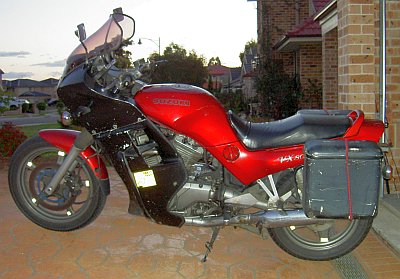
 And thus the VX800 soldiered on for a further ten years and way more than 150,000 odd kilometres before it was sold off, again, like the GSX400F, for almost as much as I had paid for it.
And thus the VX800 soldiered on for a further ten years and way more than 150,000 odd kilometres before it was sold off, again, like the GSX400F, for almost as much as I had paid for it.
 What I learned during the ownership of the VX800, was that it was a magnificent all-rounder, although I didn’t realise it at the time. I toured on it, commuted on it, scratched in the hills on it, went on dirt roads on it, and even had the opportunity to put it around a racetrack a time or two (where it surprised quite a few with its abilities).
What I learned during the ownership of the VX800, was that it was a magnificent all-rounder, although I didn’t realise it at the time. I toured on it, commuted on it, scratched in the hills on it, went on dirt roads on it, and even had the opportunity to put it around a racetrack a time or two (where it surprised quite a few with its abilities).
 All the while though, I was still of the opinion that it was something less than other motorcycles. My attitude toward it was that it was only ever an interim bike, and that there were far better bikes out there.
All the while though, I was still of the opinion that it was something less than other motorcycles. My attitude toward it was that it was only ever an interim bike, and that there were far better bikes out there.
 This line of thinking was reinforced by numerous journalists who were fairly disparaging of the VX: only 60 horsepower, not a tourer, not a sports bike, not a cruiser, weird styling; and perhaps most notable, because it didn’t sell well in Australia there must have been something wrong with it. Right? Well, maybe not. What would motorcycle journos know, anyway?
This line of thinking was reinforced by numerous journalists who were fairly disparaging of the VX: only 60 horsepower, not a tourer, not a sports bike, not a cruiser, weird styling; and perhaps most notable, because it didn’t sell well in Australia there must have been something wrong with it. Right? Well, maybe not. What would motorcycle journos know, anyway?
 I was constantly in the market for a bike to replace the VX, and test rode a wide variety of bikes which I thought would fit the bill. Invariably, the ride home on the ageing VX proved that it was not significantly worse than the newer bikes I was testing, and they offered nothing that the VX was not already delivering by way of functionality. You may have gathered by now I tend to shop with my head not my ego. And very budget conscious too. Neither chrome, bling, awesome horsepower nor amazing track times particularly do it for me.
I was constantly in the market for a bike to replace the VX, and test rode a wide variety of bikes which I thought would fit the bill. Invariably, the ride home on the ageing VX proved that it was not significantly worse than the newer bikes I was testing, and they offered nothing that the VX was not already delivering by way of functionality. You may have gathered by now I tend to shop with my head not my ego. And very budget conscious too. Neither chrome, bling, awesome horsepower nor amazing track times particularly do it for me.
 During this time, I was reading everything I could about every potential replacement bike and gradually formed the opinion, based on how I was currently using the VX, that the bike for me was going to be the best all-rounder I could find. With the growing popularity and availability of dual-sports / adventure tourers, and a much improved personal financial status, I was fast becoming spoilt for choice. In late 2006, the VX800 was sold, and after a six month stint overseas, I came home ready to buy what I believed would be my ultimate ride. Not a “forever” bike maybe, but certainly one which would fulfill my clearly identified functionality requirements.
During this time, I was reading everything I could about every potential replacement bike and gradually formed the opinion, based on how I was currently using the VX, that the bike for me was going to be the best all-rounder I could find. With the growing popularity and availability of dual-sports / adventure tourers, and a much improved personal financial status, I was fast becoming spoilt for choice. In late 2006, the VX800 was sold, and after a six month stint overseas, I came home ready to buy what I believed would be my ultimate ride. Not a “forever” bike maybe, but certainly one which would fulfill my clearly identified functionality requirements.
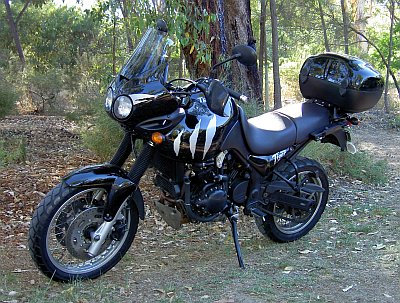
 While I was overseas I had read (over and over) a Motorcycle Trader comparison they had done on a fleet of big bore adventure bikes, and the best generalist bike among them, in my opinion, was the Triumph Tiger 955i. This was the bike which was going to be my “reward” bike. I had long wanted a Triumph, but, on paper, it also had the goods to make a great all rounder. Searching in earnest now, I continued test riding various bikes and had narrowed the field down to the Suzuki V-Strom 650 and the Tiger 955i. When a Tiger turned up at the right price, near new, low kilometres, with all the factory accessory panniers, the deal was done and I was now Triumph mounted. And very proud of it too. They’re a fine bike.
While I was overseas I had read (over and over) a Motorcycle Trader comparison they had done on a fleet of big bore adventure bikes, and the best generalist bike among them, in my opinion, was the Triumph Tiger 955i. This was the bike which was going to be my “reward” bike. I had long wanted a Triumph, but, on paper, it also had the goods to make a great all rounder. Searching in earnest now, I continued test riding various bikes and had narrowed the field down to the Suzuki V-Strom 650 and the Tiger 955i. When a Tiger turned up at the right price, near new, low kilometres, with all the factory accessory panniers, the deal was done and I was now Triumph mounted. And very proud of it too. They’re a fine bike.
 Well, that was then, and this is now, and I have a whole new perspective on what I need a motorcycle to deliver. Despite my initial enthusiasm for the Tiger, and a recognition of its capabilities, I found that living with it was proving difficult.
Well, that was then, and this is now, and I have a whole new perspective on what I need a motorcycle to deliver. Despite my initial enthusiasm for the Tiger, and a recognition of its capabilities, I found that living with it was proving difficult.
 That is to say, it is a large bike and I soon discovered it was not happy in a commuting or running about town role. That it was very tall in the saddle, and I am a bit short of leg didn’t help matters. In fact, the Tiger mostly sat in the garage while I used the wife’s 50cc SYM scooter for any run-about town tasks. So much easier. I attempted to do some mild off-bitumen riding, but again the Tiger proved to be a handful. Not only heavy, but top heavy, which made negotiating anything other than firm, smooth hard packed dirt quite a challenge. And probably overpowered for that purpose too: give the throttle a squirt to get out of sand and 100-odd horses make their presence felt immediately, which, compounded with being top heavy, really put the “adventure” into the adventure bike label. Where the Tiger excelled was as a tourer. Load it up, point it at the horizon and let ‘er go. It was a fabulous tourer, and on more than a few occasions I achieved 1000+ kilometre days. It was also a bit of a hoon bike too, in that its power to weight ratio, long travel suspension, and near dirt bike seating arrangement meant that certain behaviours (which would no doubt be frowned upon by those in authority) came pretty easily.
That is to say, it is a large bike and I soon discovered it was not happy in a commuting or running about town role. That it was very tall in the saddle, and I am a bit short of leg didn’t help matters. In fact, the Tiger mostly sat in the garage while I used the wife’s 50cc SYM scooter for any run-about town tasks. So much easier. I attempted to do some mild off-bitumen riding, but again the Tiger proved to be a handful. Not only heavy, but top heavy, which made negotiating anything other than firm, smooth hard packed dirt quite a challenge. And probably overpowered for that purpose too: give the throttle a squirt to get out of sand and 100-odd horses make their presence felt immediately, which, compounded with being top heavy, really put the “adventure” into the adventure bike label. Where the Tiger excelled was as a tourer. Load it up, point it at the horizon and let ‘er go. It was a fabulous tourer, and on more than a few occasions I achieved 1000+ kilometre days. It was also a bit of a hoon bike too, in that its power to weight ratio, long travel suspension, and near dirt bike seating arrangement meant that certain behaviours (which would no doubt be frowned upon by those in authority) came pretty easily.
 But was the Tiger really the great all rounder I had convinced myself it was? The answer is an emphatic NO! It was a great bike in certain aspects, but the fact that it did not lend itself to a wide variety of applications was reflected on its odometer. I had some very enjoyable and memorable rides on the Tiger, but over the seven years I owned it, I had hardly run up 35000 kilometres: I had far exceeded that in just two years on the VX800. I was simply not enjoying riding the Tiger, and when I found I was using the car in preference to the Tiger, the decision was made to move it on. I had a perfectly good bike in the garage, and yet I was missing having a bike to ride. Go figure. Don’t get me wrong, I have the highest regard for the Tiger; it was simply not the right bike for me.
But was the Tiger really the great all rounder I had convinced myself it was? The answer is an emphatic NO! It was a great bike in certain aspects, but the fact that it did not lend itself to a wide variety of applications was reflected on its odometer. I had some very enjoyable and memorable rides on the Tiger, but over the seven years I owned it, I had hardly run up 35000 kilometres: I had far exceeded that in just two years on the VX800. I was simply not enjoying riding the Tiger, and when I found I was using the car in preference to the Tiger, the decision was made to move it on. I had a perfectly good bike in the garage, and yet I was missing having a bike to ride. Go figure. Don’t get me wrong, I have the highest regard for the Tiger; it was simply not the right bike for me.
 So, now without a bike in the garage, I was again in the hunt for the bike. My criteria had broadened somewhat, and I was even considering some of the bikes from the 70s and 80s: early 70’s CB750 Honda, 80’s GS Suzukis, etc, as these had the potential (and hard earned reputation) to deliver that elusive all rounder capability. At the other end of the scale were some of the new Japanese and European offerings: BMW F700GS and F800ST, Triumph Bonneville, Honda VFR800, etc. Even the venerable Suzuki DL650 V-Strom came in for a revisit and consideration: they really are an excellent bike for the money, by the way. After much soul-searching and rational, sober thought, I worked out I was actually looking for another Suzuki VX800; in terms of its functionality and ride-ability at least, if not the actual bike itself. As an aside, a few VX800s are still out there, but pretty rare and hard to find one which hasn’t been molested in some way. Personally, I reckon those “in the know” are snapping them up and hoarding.
So, now without a bike in the garage, I was again in the hunt for the bike. My criteria had broadened somewhat, and I was even considering some of the bikes from the 70s and 80s: early 70’s CB750 Honda, 80’s GS Suzukis, etc, as these had the potential (and hard earned reputation) to deliver that elusive all rounder capability. At the other end of the scale were some of the new Japanese and European offerings: BMW F700GS and F800ST, Triumph Bonneville, Honda VFR800, etc. Even the venerable Suzuki DL650 V-Strom came in for a revisit and consideration: they really are an excellent bike for the money, by the way. After much soul-searching and rational, sober thought, I worked out I was actually looking for another Suzuki VX800; in terms of its functionality and ride-ability at least, if not the actual bike itself. As an aside, a few VX800s are still out there, but pretty rare and hard to find one which hasn’t been molested in some way. Personally, I reckon those “in the know” are snapping them up and hoarding.
 As it turned out, after much searching I was almost ready to lay down my hard earned on a new Honda NC750S, amazing value for money, when an ad in Gumtree caught my eye. Here was a 2001 Yamaha XJ900S Diversion, with a whole raft of accessories, and a mere 20,000 kilometres on the odometer. And all for about half the money I got on the sale of the Tiger; I had to check it out. Years earlier, when I still had the VX800, I had test ridden a Diversion but had discounted it as being very bland; almost soul-less after the “character” of the V-twin Suzuki. Stepping back onto this Diversion, after the free-revving triple of the Tiger, I was now much more comfortable with the slick smoothness of the inline four. In terms of size, weight and seating position, the Yamaha felt like I was back on the VX, although performance was notably up a bit. Not in the league of the Tiger, but nothing to sniff at either, with bags of low-down torque thrown in for good measure.
As it turned out, after much searching I was almost ready to lay down my hard earned on a new Honda NC750S, amazing value for money, when an ad in Gumtree caught my eye. Here was a 2001 Yamaha XJ900S Diversion, with a whole raft of accessories, and a mere 20,000 kilometres on the odometer. And all for about half the money I got on the sale of the Tiger; I had to check it out. Years earlier, when I still had the VX800, I had test ridden a Diversion but had discounted it as being very bland; almost soul-less after the “character” of the V-twin Suzuki. Stepping back onto this Diversion, after the free-revving triple of the Tiger, I was now much more comfortable with the slick smoothness of the inline four. In terms of size, weight and seating position, the Yamaha felt like I was back on the VX, although performance was notably up a bit. Not in the league of the Tiger, but nothing to sniff at either, with bags of low-down torque thrown in for good measure.
 A closer inspection of the Yamaha put a whole lot of ticks in a whole lot of boxes: small-ish dimensions, low seat height, low weight distribution, shaft drive, centre stand, weather protection (full fairing), racks for panniers and top box, excellent range, comfortable seating for two, even under-seat helmet hooks; what was not to like. Furthermore, the owner was meticulous in his care and maintenance of the bike so it really was in near new condition. Much paper shuffling ensued and the Yamaha was in my garage the next day.
A closer inspection of the Yamaha put a whole lot of ticks in a whole lot of boxes: small-ish dimensions, low seat height, low weight distribution, shaft drive, centre stand, weather protection (full fairing), racks for panniers and top box, excellent range, comfortable seating for two, even under-seat helmet hooks; what was not to like. Furthermore, the owner was meticulous in his care and maintenance of the bike so it really was in near new condition. Much paper shuffling ensued and the Yamaha was in my garage the next day.
 And this brings us to the present, and the point of my writing. This “old” Yamaha, arguably the last and most refined iteration of the old technology: carburettor aspirated, air cooled, steel tube framed, transverse mounted in-line four cylinder. The last of the dinosaurs to come out of Japan, it continues to deliver an outstanding capability across a whole range of purposes. Yamaha got it right. Perhaps most importantly, this bike continues to put a grin on my face every time I fire it up. I ride it at every opportunity, in all weathers, and have managed to rack up a further 20,000 kilometres in the two years it’s been in my possession. It has not missed a beat, is very economical to run (unleaded 91 RON to deliver a consistent 5.5 l/100 kilometres), and is returning huge kilometres from its average (non-specialist, therefore relatively inexpensive) Pilot 4 tyres. It even runs mineral oil at a fraction of the cost of the fully synthetic necessary for most modern engines. Last year, on a charity bike ride, it covered 3500 kilometres in seven days during the most atrocious wet weather conditions, and performed flawlessly throughout. I have nothing but praise for the bike.
And this brings us to the present, and the point of my writing. This “old” Yamaha, arguably the last and most refined iteration of the old technology: carburettor aspirated, air cooled, steel tube framed, transverse mounted in-line four cylinder. The last of the dinosaurs to come out of Japan, it continues to deliver an outstanding capability across a whole range of purposes. Yamaha got it right. Perhaps most importantly, this bike continues to put a grin on my face every time I fire it up. I ride it at every opportunity, in all weathers, and have managed to rack up a further 20,000 kilometres in the two years it’s been in my possession. It has not missed a beat, is very economical to run (unleaded 91 RON to deliver a consistent 5.5 l/100 kilometres), and is returning huge kilometres from its average (non-specialist, therefore relatively inexpensive) Pilot 4 tyres. It even runs mineral oil at a fraction of the cost of the fully synthetic necessary for most modern engines. Last year, on a charity bike ride, it covered 3500 kilometres in seven days during the most atrocious wet weather conditions, and performed flawlessly throughout. I have nothing but praise for the bike.
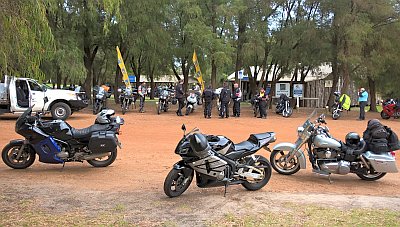
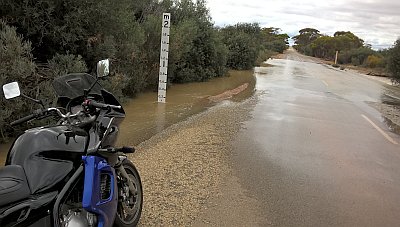
 So, what is this telling us? Here is an example of a bike from yesterday which delivers within its design brief today as effectively as any number of modern bikes within the same design brief. One cannot ask more than that in engineering and functionality terms. Ultimately though, the XJ900S gives me great pleasure and satisfaction to own and ride, and that, surely, is the main criteria by which all motorcycles, old and new, should be judged. The XJ900S: An oldie, and most certainly a goldie!
So, what is this telling us? Here is an example of a bike from yesterday which delivers within its design brief today as effectively as any number of modern bikes within the same design brief. One cannot ask more than that in engineering and functionality terms. Ultimately though, the XJ900S gives me great pleasure and satisfaction to own and ride, and that, surely, is the main criteria by which all motorcycles, old and new, should be judged. The XJ900S: An oldie, and most certainly a goldie!
 Thanks again Ken. I love that sentence I highlighted above - how true that is! As I said at the top, practicality as an all-rounder; that is something that is missing in most new bikes today: and that’s what makes bikes like the old XJ900 such a good solution in today’s world of motorcycling – for those of us who want a bike that is good in that wide variety of roles anyway.
Thanks again Ken. I love that sentence I highlighted above - how true that is! As I said at the top, practicality as an all-rounder; that is something that is missing in most new bikes today: and that’s what makes bikes like the old XJ900 such a good solution in today’s world of motorcycling – for those of us who want a bike that is good in that wide variety of roles anyway.
Click here to return to the front page. Click your BACK button to return to the previous page.

